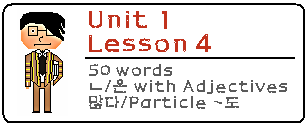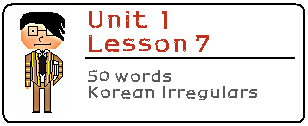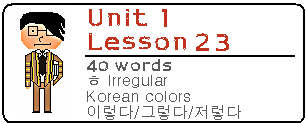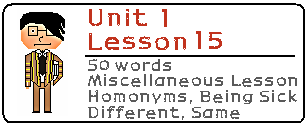In this lesson, you will learn the basic structure in Korean sentences and how to create sentences using the word 이다 (to be). Using 이다, you will learn how to create sentences like “that man is a teacher” and “this thing is a pen.” In addition, some essential grammar notes will be presented to get you started correctly in your path to learn Korean!
Also available in Español, Русский, Français, 中文, Deutsch, Português, Nederlands, Ελληνικά and Čeština
 Description
DescriptionIn this lesson, you will learn two more particles (이/가) to use in Korean sentences. In addition to those, you will learn how to use the word 있다 to make sentences like “I am at school” and “I have a pen.”
Also available in Español, Русский, 中文, Português, Français, Nederlands, Deutsch and Ελληνικά
 Description
DescriptionIn this lesson, you will learn how to make sentences using adjectives and verbs! We will start off with very simple sentences in this lesson, but later you will be making sentences complex enough to make your head explode. In addition to that, you will learn how to say “my” thing, or “his” thing by using the possessive particle, 의. Finally, we will take an initial look at the differences between 좋다 (to be good) and 좋아하다 (to like).
Also available in Español, Русский, Français, 中文, Português, Nederlands, Deutsch and Ελληνικά
 Description
DescriptionIn this lesson, you will learn how to change adjectives from their dictionary form to be able to modify nouns. Using this, you will be able to create more complex sentences! In addition to this, you will learn the meaning of the Korean particle ‘도’ and when to use it. Also, I included some common greeting words, even though I feel you should put off learning them for just a few more lessons!
Also available in Español, Русский, Français, 中文, Português, Nederlands and Deutsch
 Description
DescriptionThis lesson will most likely be the hardest step you will have to take when learning Korean. There is a lot of content in this lesson, but don’t get too worried! The knowledge that you get from this lesson will literally be the first major building block you will need to start conjugating verbs and adjectives into the past, present and future forms. In addition, you will apply your knowledge of conjugating to 있다 and 있다 – two words that look the same, but have slightly different meanings.
Also available in Español, Français, Русский, Português, Nederlands, Deutsch, Ελληνικά and 中文
 Description
DescriptionIn this lesson, you will add to what you learned in Lesson 5. In Lesson 5, you learned how to conjugate using one method. In this lesson, you will learn how to conjugate verbs and adjectives in polite and casual ways. You will also learn how to use the word “I” depending on the respect you need to show during speech.
Also available in Español, Русский, Português, Nederlands, Deutsch, Français and Ελληνικά
 Description
DescriptionIn this lesson, you will learn all the Korean irregulars you will need to know when conjugating sentences. Like the previous lesson, this lesson is very heavy on grammar. Nonetheless, these irregulars must be understood and memorized if you want to conjugate verbs/adjectives properly. If you understand everything, but need to refresh your mind on exactly how to implement these irregulars, check out our Irregular Quick Reference page.
Also available in Español, Русский, Français, Português and Ελληνικά
 Description
DescriptionUse this lesson as a Quick Guide to remembering the various irregulars in Korean! If you can’t understand an irregular perfectly, check out Lesson 7 where each irregular is explained in detail. Or you could always ask us a question by making a comment!
Also available in Русский, Español, Français, Português and Ελληνικά
 Description
DescriptionIn this lesson, you will learn a major part of speech that you haven’t learned about yet: Adverbs! You will be introduced to the various types of adverbs, and how you can use them in Korean sentences. In addition, you will learn about how to create negative sentences in a variety of ways.
Also available in Español, Русский, Português, Nederlands, Deutsch, Français and Ελληνικά
______________________________
Lessons 1 – 8 Mini Test
______________________________
In this lesson, you will learn how to conjugate 이다 which is conjugated differently than other verbs and adjectives. You will learn about how to conjugate 이다 in the four honorific formalities that you already know. In addition, you will learn how to use 이다 to conjugate verbs/adjectives to the future by creating endings like: 먹을 것이다.
Also available in Русский, Français, Español, Português, Nederlands, Deutsch and Ελληνικά
 Description
DescriptionIn this lesson, you will be introduced to two different sets of Korean numbers and how to use them in situations. After learning the numbers, you will learn how to count things in Korean by using numbers and a counter. With these numbers, you will also learn how to tell the time in Korean. Finally, two words related to time (처음 and 마자막) will be introduced to you before you move on to learn more about ‘time’ in Lesson 11.
Also available in Русский, Français, Español, Português, Nederlands and Deutsch
 Description
DescriptionIn this lesson, you will build on what you learned in Lesson 10 by learning how to use a variety of different words of time in Korean. Using these words, you will be able to say “I did ____ for 2 months” or “I didn’t ____ last week.” You will also learn whether you should use the pure Korean or Sino-Korean numbers when talking about these different words of time.
Also available in Русский, Français, Español, Português, Nederlands and Deutsch
 Description
DescriptionIn this lesson, you will learn more of the most commonly used Korean Particles. Using particles like 들, 만, 에서, 부터, 까지 and 로, you will be able to create more complex sentences. Additionally, you will learn tips on how to use these particles correctly in conversation!
Also available in Русский, Español, Português, Nederlands and Français
 Description
DescriptionIn this lesson, you will continue to learn some of the most commonly used Korean Particles. Here, you will learn how to say “and” (와/과, 랑/이랑, 하고), “with” (와/과 함께, 랑/이랑, 하고), “to” (에게, 께, 한테), “from” (으로부터, 어게서), “for” (를/을 위해) and “about” (에 대해) in sentences.
In this lesson, you will learn something that will almost certainly make your head spin. You will learn about passive verbs in Korean – and one of the main reasons this concept is so difficult is that most people are not aware of passive verbs in their own language. Passive verbs aren’t used that much, but they are used sometimes and it is a very important concept that you must know before going any further. I am sure you will be confused after this lesson… if so, ask us a question!
Also available in Русский, Português, Nederlands, Español and Français
In this lesson, you will learn a bunch of different miscellaneous Korean Grammar points that I couldn’t put into any other specific lesson. In this lesson, you will learn about adding 아/어 하다 to words like 좋다 and 싫다, and how sometimes adjectives in Korean can act on objects (which usually can never be done). You will learn about Korean Homonyms like 들다 and 걸리다. You will also learn about compound verbs in Korean, and how to express yourself when you are sick.
Also available in Русский, Français, Português, Nederlands and Español
 Description
DescriptionIn this lesson, you will learn about ~적 and ~스럽다, which can be added to some words in Korean to give them slightly different meaning. Use this lesson to learn about how to properly use these two in Korean sentences!
Also available in Русский, Português, Español and Nederlands and Français
______________________________
Lessons 9 – 16 Mini Test
______________________________
In this lesson, you will be introduced to your first (of very many) connecting particles in Korean. You can usually use these particles to separate two two ideas/phrases/sentences. In this lesson you will learn about 고 and how it can be used in sentences, also using the example of ~고 싶다. You will also learn that some words (usually position-like words) play by different rules than most verbs in these situations.
Also available in Русский, Français, Deutsch, Español and Nederlands
 Description
DescriptionIn this lesson, you will continue learn applications for the particle ~고. Specifically, you will learn about how you can use ~고 있다 to mean “I am … ing.” You will also learn that you can’t use this with verbs of position (stand, sit, etc). In addition, you will learn about how to add 어/어지다 to adjectives to give them the meaning of “it gets (adjective)” to make sentences like “it got cold.”
Also available in Русский, Deutsch, Español and Nederlands
 Description
DescriptionIn this lesson, you will learn how to make comparative and superlative sentences in Korean. Using comparative sentences, you will learn how to make sentences like “I am more beautiful than you” or “he is faster than his brother.” Using superlative sentences, you will learn how to make sentences like “I am the most handsome person in the world.” In addition, we will take an in-depth look at the word 더, which is commonly used in comparative sentences.
Also available in Русский, Español, Nederlands and Français
 Description
DescriptionIn this lesson, you will learn how to use the words 잘/못 and 잘하다/못하다 to indicate that you do something ‘poorly/well.’ It gets a little complicated in this lesson, especially when distinguishing 못 from 못하다 and 잘 from 잘하다. Nonetheless, everything will be explained to you very thoroughly!
Also available in Русский, Español, Nederlands and Français
 Description
DescriptionIn this lesson, you will learn how to modify your sentences to ask questions in Korean. You will first learn how to do this without any ‘question’ words (Did you eat yesterday?), and then you will learn about how to apply words like “why,” “when,” “where” and “who” to make questions. This lesson is so long, I had to split it up into two sections. So, this lesson will continue into the next lesson, where you will learn more about how to ask questions.
Also available in Русский, Español, Nederlands and Français
 Description
DescriptionIn this lesson, you will build on what you learned in Lesson 21 by learning more ways to ask questions in Korean. Specifically, you will learn how to ask questions using the following words: how, what, which and how many. Asking questions with “how many” is slightly more confusing than the rest, so we will spend some time showing you the different ways you can use that.
This lesson is also available in Русский, Español and Français
 Description
DescriptionIn this lesson, you will learn how to use colors in Korean by applying the ㅎ irregular. In addition, you will learn about the words 이렇다, 그렇다 and 저렇다 and how the ㅎ irregular can be applied to those words.
 Description
DescriptionIn this lesson, you will learn how to apply some more words (전, 후, 이래로, 안, 이내) after words of time to mean (after, before, since, within). The information in this lesson will build on previous lessons where you learned about dealing with time in Korea.
 Description
DescriptionIn this lesson, you will learn how to use words like Anybody, Somebody, Everybody, Nobody, Nothing and Nowhere in Korean. These words are different in a lot of ways from other words in Korean, so make sure you pay attention!
______________________________
Lessons 17 – 25 Mini Test
______________________________
Unit 1 Test
______________________________
______________________________






